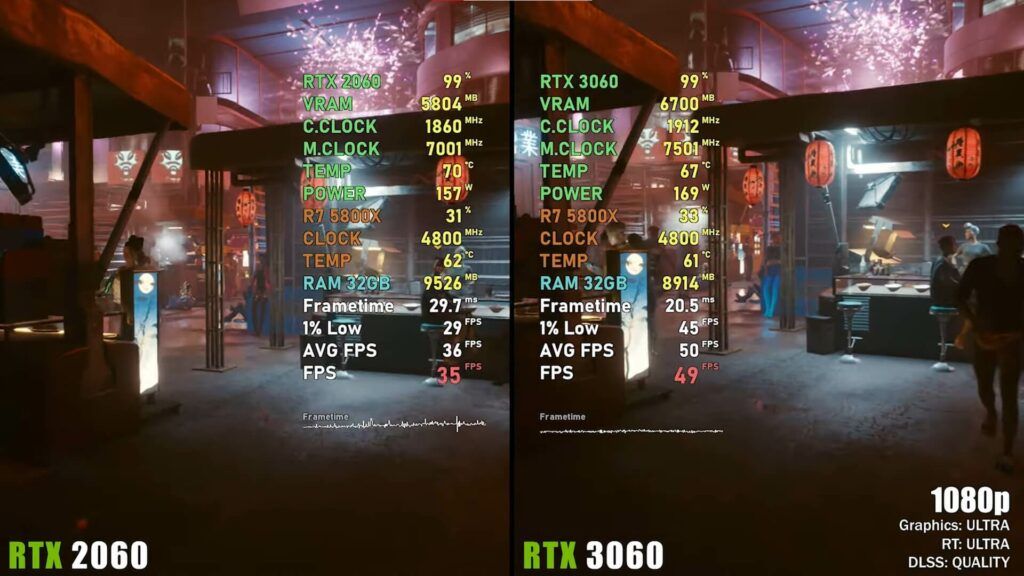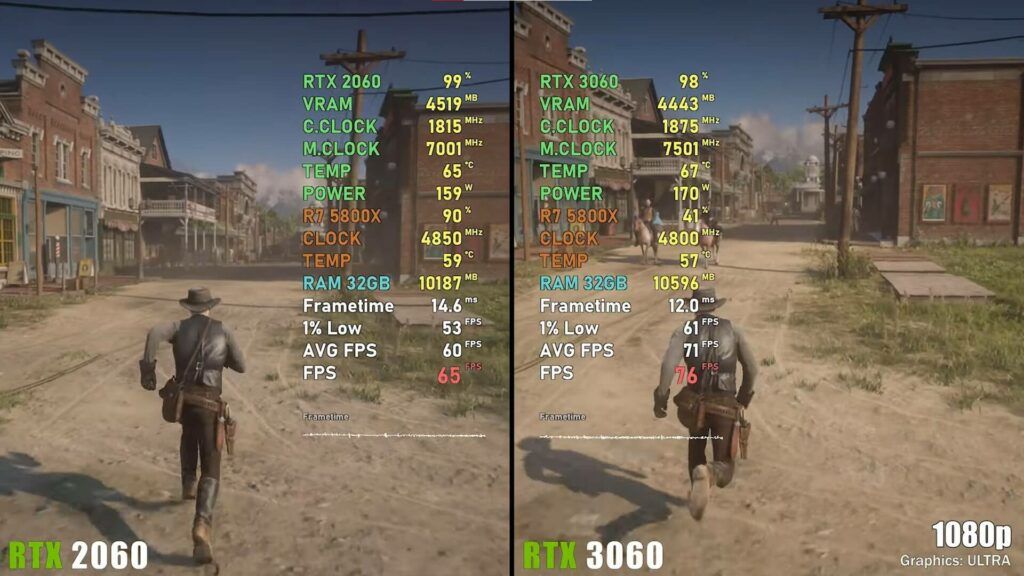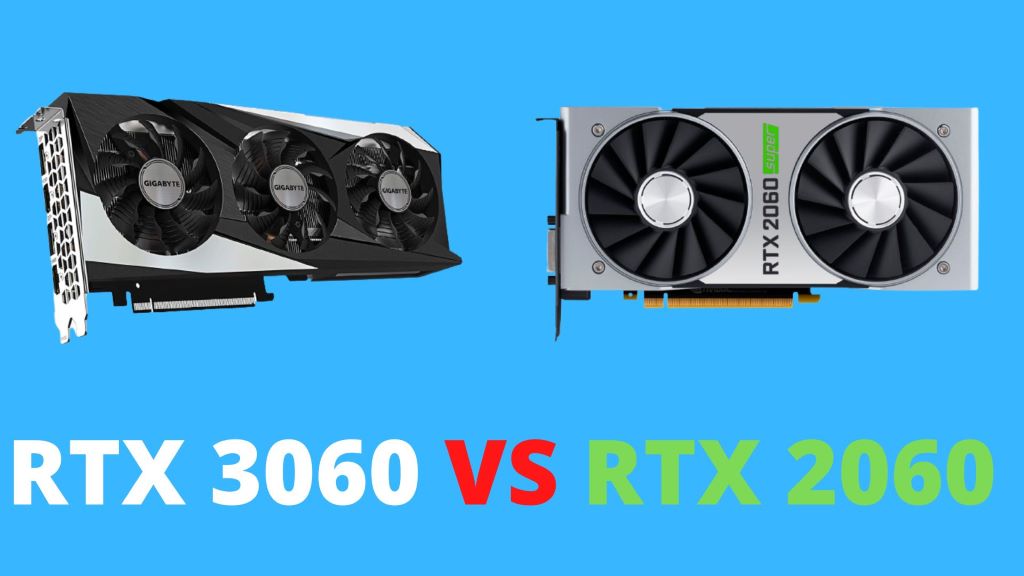So you’re trying to decide between the RTX 2060 vs 3060 graphics cards, huh? I feel you. With so many GPU options out there nowadays, trying to pick the right one can make your head spin. Well, have no fear – I’m here to help break down the differences between these two popular graphics cards so you can decide which is the better fit for your needs and budget. We’ll compare everything from performance and features to power and price. Time for an old-fashioned graphics card showdown!
Getting Started: What Exactly Are These Cards?
First things first, let’s make sure we all know what we’re dealing with here. The RTX 2060 and RTX 3060 are both mid-range graphics cards made by Nvidia.
The RTX 2060 came out back in 2019. At the time, it offered great 1080p and 1440p gaming performance at an affordable price point. The 2060 can handle real-time ray tracing and also features Nvidia’s AI-powered DLSS (Deep Learning Super Sampling) technology.
The RTX 3060 is part of Nvidia’s newer 30-series lineup based on the Ampere architecture. Released in 2021, the 3060 delivers improved performance over the 2060, especially when it comes to ray tracing and DLSS. It’s aimed at the same segment of the market – 1080p and 1440p gamers wanting smooth framerates without breaking the bank.
So in a nutshell – the 3060 is the newer, more advanced card that supersedes the 2060. But does that make it definitively better for your situation? Let’s dig deeper…

Performance and Features
These cards may occupy a similar spot in Nvidia’s product stack, but there are some key differences when it comes to performance and capabilities.
Right off the bat, the RTX 3060 has higher core clocks – its boost clock reaches up to 1777MHz, while the RTX 2060 tops out at 1680 MHz. More MHz = more performance, so the 3060 has an inherent advantage in raw graphics processing power.
The 3060 also has faster and newer GDDR6 memory compared to the 2060’s GDDR6. Its 192-bit bus and 15Gbps VRAM gives it a total memory bandwidth of 360GB/s, a big jump over the 2060’s 336GB/s.
Plus, the Ampere architecture brings 2nd-gen RT cores for ray tracing and 3rd-gen tensor cores for AI and machine learning. Both of those lead improved performance in games that utilize those advanced graphics features.
Speaking of features, both of these GPUs support:
- Nvidia DLSS (Deep Learning Super Sampling)
- DirectX 12 Ultimate
- OpenGL 4.6
- HDCP 2.3
- AV1 Decode
So you’re covered on the feature front with either option. But the 3060 pulls ahead when looking at the specs and technology inside these cards. The extra muscle makes a difference in games, as we’ll see soon when we compare benchmarks.
Before we get there though, a quick note on variants and configurations. Both the RTX 2060 and 3060 have models made by partners like Asus, MSI, and Zotac that offer different coolers, form factors, and slight performance tuning. I’ll be referring to the stock Nvidia models, but keep in mind aftermarket options exist too.
Alright, let’s check out some game benchmarks!
Performance Benchmarks: 1080p and 1440p Testing
Now for the fun part – how do these graphics cards actually perform head-to-head? I’ll be looking at tested gameplay framerates at both 1080p and 1440p resolutions. These numbers reflect the typical experience you can expect with the settings maxed out.
Assassin’s Creed Valhalla
- 1080p – RTX 2060: 48 fps // RTX 3060: 55 fps
- 1440p – RTX 2060: 29 fps // RTX 3060: 34 fps
Call of Duty: Warzone
- 1080p – RTX 2060: 75 fps // RTX 3060: 98 fps
- 1440p – RTX 2060: 65 fps // RTX 3060: 83 fps
Cyberpunk 2077
- 1080p – RTX 2060: 32 fps // RTX 3060: 37 fps
- 1440p – RTX 2060: 21 fps // RTX 3060: 24 fps
Fortnite
- 1080p – RTX 2060: 74 fps // RTX 3060: 92 fps
- 1440p – RTX 2060: 62 fps // RTX 3060: 77 fps
Red Dead Redemption 2
- 1080p – RTX 2060: 52 fps // RTX 3060: 60 fps
- 1440p – RTX 2060: 36 fps // RTX 3060: 41 fps
You can see the RTX 3060 outperforms the 2060 in every game – usually 15-20% faster at 1080p and 20-25% faster at 1440p. Those extra frames will come in handy for high refresh rate gaming if you have a 120Hz or 144Hz monitor.
Also note both cards struggle to maintain smooth 1440p gameplay in very demanding games like Cyberpunk 2077 – you may need to lower some graphics settings there. But in most popular multiplayer titles, the 3060 can handle 1440p with room to spare.
Let’s talk ray tracing too. The 3060’s upgraded RT cores allow it to run ray traced lighting and reflections much better than the 2060. You’re looking at 30-50% higher ray tracing performance depending on the game. DLSS can help boost FPS with minimal image quality loss as well.
So all around, the RTX 3060 takes the cake when evaluating raw graphics horsepower. If you’re just chasing frames per second, it pulls notably ahead of the RTX 2060.
Power Consumption and Thermals
Moving onto power and thermals, an area where the RTX 2060 shines over its successor. The 3060 is built on Nvidia’s power-hungry Ampere architecture, while the 2060 uses the more efficient Turing design.
Here’s how the maximum board power ratings compare:
- RTX 2060: 160 watts
- RTX 3060: 170 watts
That extra 10 watts adds up, especially when the 3060 already runs hotter thanks to its more densely-packed GPU die. In terms of operating temperatures, the 2060 peaks around 73 °C under full load, while the 3060 can reach upwards of 78 °C in demanding gaming sessions.
As a result, you’ll want a case with decent airflow to handle a 3060. Extra heat also means more fan noise as the card works hard to vent it out. The RTX 2060 generally runs quieter since it doesn’t get as hot to begin with.
When it comes to real-world power draw while gaming, you can expect about 30 more watts of consumption from the 185W RTX 3060 versus the 155W RTX 2060 on average. Over time, that difference has an impact on your electricity bill – something to keep in mind!
Cost and Value Comparison
Alright, let’s talk dollars and cents! Pricing can ultimately be the deciding factor on which graphics card you go with, so what’s the MSRP breakdown look like?
| Graphics Card | MSRP |
| RTX 2060 (6GB) | $299 |
| RTX 3060 (12GB) | $329 |
At launch, the RTX 3060 rang in $30 more than the 2060. However, we have to consider the overall value you’re getting at each price point. Remember, the 3060 is the newer, faster card with extra VRAM – so that small premium may just be worth it!
Plus, in the current market, most 2060 and 3060 models sell way above MSRP due to demand outweighing supply. It’s not uncommon to find RTX 2060s selling for $400 or more and 3060s at $500 and up.
At those inflated prices, I give the value edge to the RTX 3060. You’re getting superior 1080p and 1440p gaming performance for every extra dollar you spend over MSRP with the 3060 versus the old-gen 2060. Paying current market prices sucks, but you might as well snag the better card!
There’s also more long-term value in the 3060 as it’ll age more gracefully. Games keep getting bigger and more complex. The 3060’s extra VRAM future-proofs it to tackle next-gen titles that may need over 6GB graphics memory. Plus DLSS and advanced RT cores ensure this GPU stays capable and relevant for longer. Nice!

Which Card Should You Buy?
We’ve covered a whole lot of ground comparing these two graphics cards! Let’s recap the key differences:
- The RTX 3060 performs faster overall
- It offers better ray tracing capabilities
- Extra VRAM improves longevity and future-proofing
- But the RTX 2060 is more power efficient
- And it runs cooler and quieter as a result
So which one is the right buy for your needs? Here are some quick tips:
- At MSRP, either card works, but I suggest spending up for the 3060 if possible. You get what you pay for.
- If you mainly play competitive esports titles, save cash with a 2060. You won’t need the 3060’s extra horsepower there.
- The 3060 gives you extra headroom for visually demanding story games. Go with it if eye candy matters!
- Get the 2060 for small form factor builds where heat output is a concern.
- Likewise for pre-builts with lower wattage power supplies. A 750W PSU should run either card safely.
- If you stream, create content, or use GPU-accelerated productivity apps, the 3060’s extra VRAM and encoder come in handy.
Hopefully that gives you some direction on deciding between the RTX 3060 and 2060. But you really can’t go wrong either way – both are capable cards for 1080p and 1440p gaming. It mainly comes down to your budget, use case, and if you value raw power or efficiency more.
The 3060 opens the door for higher framerates and crisper visuals. But a 2060 lets you still enjoy smooth gameplay and modern features like ray tracing at a lesser cost (when prices are reasonable!). Evaluate what specs matter most to you and let that guide your buying decision between these stellar GPUs.
Well, that just about wraps up this graphics card showdown! Hopefully now you feel equipped to pick the right Nvidia card for your PC build or upgrade. Let me know if you have any other questions – I’m always happy to chat more about gaming hardware!
Frequently Asked Questions
Q: How big of a performance difference is there between the RTX 3060 and 2060 in percentage terms?
A: On average, the RTX 3060 delivers around a 20% performance improvement over the RTX 2060 at 1080p resolution, and 25% faster performance at 1440p.
Q: Which GPU would pair better with Ryzen 5 3600 – RTX 3060 or 2060?
A: The Ryzen 5 3600 would pair slightly better with the RTX 2060. At 1440p you may become GPU limited in some games with the faster 3060. But overall performance would still be great with either card.
Q: I mostly play esports games like Valorant, should I save money with the 2060?
A: Yes, for competitive esports titles, you generally want to prioritize chasing high FPS over visuals. An RTX 2060 is perfectly capable of hitting 200+ fps in games like Valorant, so I’d go that route to save money.
Q: Can both cards handle gaming at 4K resolution?
A: Neither card can reliably run modern AAA game titles at 4K with max settings and get 60 fps. You’ll need to lower some graphics settings at 4K with both the RTX 2060 and 3060. Better to target 1440p gaming with these GPUs.
Q: How future-proof is the 12GB VRAM on the RTX 3060?
A: The 3060’s 12GB framebuffer future-proofs it very well to play games for years to come. As games continue adding higher resolution textures, it will handle them better than the 6GB 2060 in the long run. You’re more “future-proof” with the 3060 in that regard.
Conclusion
Here’s a shorter version: The RTX 3060 is the newer, more advanced GPU and takes the outright performance crown due to faster clock speeds, upgraded architecture, and extra memory capacity. It’s best for smooth high-framerate 1080p and 1440p gameplay. How many types of computer maintenance are there? Just as selecting the right RTX card depends on your PC’s needs and budget, computer maintenance encompasses various types, each crucial for ensuring optimal performance and longevity, much like the enduring reliability of the last-generation RTX 2060 in high-refresh gaming scenarios, where it efficiently gets the job done while conserving power and minimizing heat.



